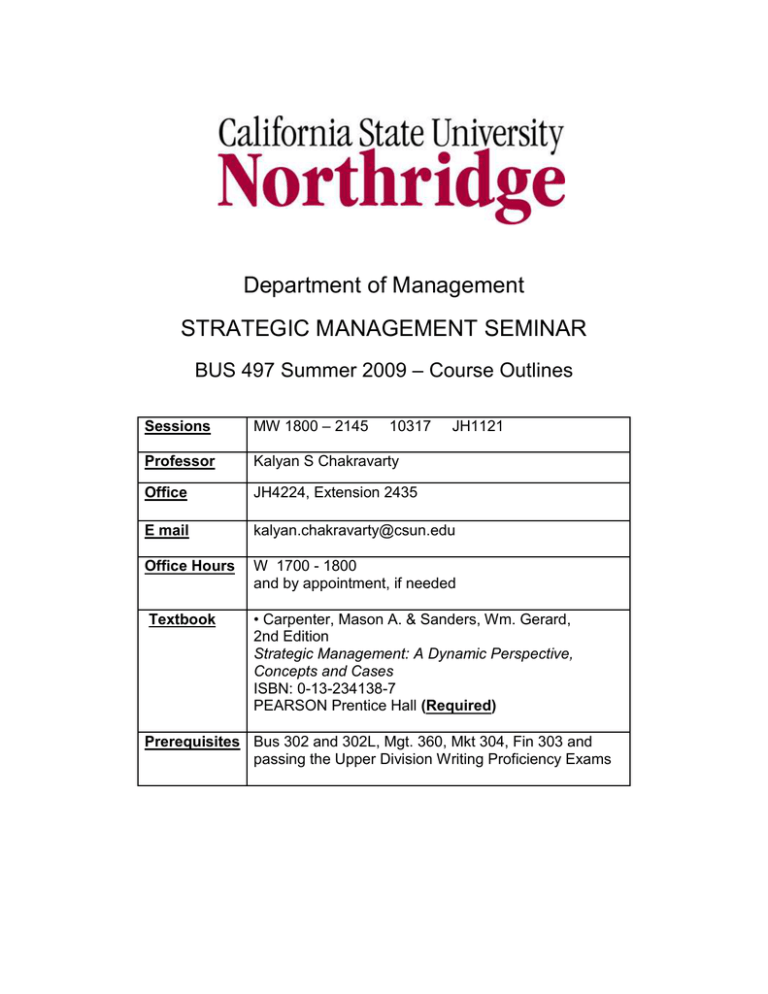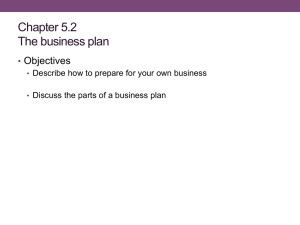
Department of Management
STRATEGIC MANAGEMENT SEMINAR
BUS 497 Summer 2009 – Course Outlines
Sessions
MW 1800 – 2145
Professor
Kalyan S Chakravarty
Office
JH4224, Extension 2435
E mail
kalyan.chakravarty@csun.edu
Office Hours
W 1700 - 1800
and by appointment, if needed
Textbook
• Carpenter, Mason A. & Sanders, Wm. Gerard,
2nd Edition
Strategic Management: A Dynamic Perspective,
Concepts and Cases
ISBN: 0-13-234138-7
PEARSON Prentice Hall (Required)
10317
JH1121
Prerequisites Bus 302 and 302L, Mgt. 360, Mkt 304, Fin 303 and
passing the Upper Division Writing Proficiency Exams
Course Description
This capstone course has been designed to introduce the principles of strategic
management. It is an integrative and interdisciplinary course providing a broad view
of the organization and its environment that includes buyers/consumers, suppliers,
competitors, complementors, and the government – while taking a general
management perspective throughout the curriculum.
The emphasis of the course will be on sharpening the analytical and decisionmaking skills necessary for strategy formulation, implementation and control at both
the corporate and business levels.
The learning objectives are:
1. To identify the key issues faced by a firm and analyze its internal strengths
and weaknesses in the context of current environmental forces impacting the
firm.
2. To see the firm as a whole while examining critically how policies in each
function like finance, marketing, manufacturing and human resources can be
synthesized and integrated into an overall competitive strategy.
3. To be able to recommend a set of viable strategies that the firm might pursue
and communicate this analysis in a concise and persuasive fashion.
4. To understand key implementation issues that managers need to deal with,
while making relevant and reasonable strategic recommendations for the firm.
Preparations
The course will have a uniform blend of a number of teaching methodologies and
aids with a strong focus on group work including the analysis of a number of cases,
articles, etc. The students are expected to prepare themselves well in advance
before each session in order to participate in the discussions meaningfully. The
assigned readings must be read thoroughly before coming to the class in order to
derive maximum mileage from each session.
Course Work
The evaluation and grading will be based on the following course work. The
components described below are designed, both independently and collectively, to
achieve the course objectives. Each component is important both by itself and as a
key part of the overall system (so any major omission may lead to an F for the
course).
Industry Analysis
Competitors Analysis
Middle Term Test (3)
Punctuality, Attendance, Participation
Total:
25 pts
20 pts
45 pts
10 pts
100 pts
STRATEGIC MANAGEMENT SEMINAR BUS 497 Summer 2009
2
A. Industry Analysis: Group Project (25%)
Students will form groups of five or less, and each group will conduct an in-depth
analysis of one INDUSTRY (a different one for each group). They will research the
writings related to this industry, and apply the models described in the class to
analyze this industry.
The aspects to be covered should include:
(1) The basics of the industry (including a basic description of the industry, the basic
technology and process, customer bases, suppliers and other significant
stakeholders as the group members see appropriate), (2) the general environment,
(3) the industry environment (the five forces model and other relevant industry
analysis models when applicable), (4) the interplays among the major competitors in
this industry (competitive approaches and strategic groups), and (5) the strategic
recommendations based on your analysis to the competing firms in this industry. The
outcome of this paper should be a better understanding of the industry in particular
and the ability to understand broad issues relevant to strategic management in
general.
The group will then make a formal presentation of the analysis in the class, with
each member of the group getting an opportunity to deal with a section of the
presentation. The total time allotted for each group will be thirty minutes. Please
practice prior to the presentation so that you will be able to finish the report within the
given time limit. The presentation of each group will be evaluated by the instructor
using predetermined criteria that include presentation quality (introduction, style,
structure, preparation, and visual aids) and substances specified above. Each group
will also submit a report. This report will be evaluated by the instructor. All references
must be specified on a separate page. We will also utilize electronic submission for
the project report.
The industry to be analyzed will be determined with students’ inputs, and dates fixed
in advance for the presentations. The data used for the analysis and presentation
should be up-to-date and could be from primary or published data sources, and all
the analyses will be conducted in the context of the course and its coverage.
Information about the reference materials is available in the textbook and from the
library.
The completed report must be turned in on the day the group makes its
presentation.
B. Key Competitors Analysis: Triad Project (20%):
Students will form groups of three (triads), and each group will conduct an in-depth
comparative analysis of two competing firms in the same industry (a different one
for each group) to be allotted at an appropriate time. They will research the writings
related to these two firms in the prescribed template, and apply the models
STRATEGIC MANAGEMENT SEMINAR BUS 497 Summer 2009
3
described in the class to analyze them and present their strategic recommendations
for the firms.
The total time allotted to each triad will be twenty minutes. Once again, please
practice prior to the presentation to ensure its satisfactory completion within the
stipulated time limit. Each triad will also submit a report for evaluation by the
instructor. More details shall be provided later in the course.
The aspects to be covered should include:
(1) Evaluation of the current performance of the firms
How successful have the strategies been in generating an above-average financial
performance of the firm over time and in relation to the industry and competitors?
(2) Comparing the two competing firms on prescribed parameters
Faced with the same industry environment, examine how and why the firms pursued
the strategies they did.
(3) Strategic recommendations by the triad
What are your recommendations for each of them? How would you change their
strategies? What recommendations do you have for implementation?
The completed report must be turned in on the day the triad makes its
presentation.
C. (15% x 3) Middle Term Test:
There will be three non-cumulative middle term tests. They will consist of a
combination of multiple choice questions, true/false statements, and short essays on
topics related to course curricula.
D. Punctuality, Attendance and Class Participation (10%)
Class attendance is absolutely essential. There will be no penalty for those with a
maximum of two absences. Students with three or more unexcused absences
will run the risk of even failing in the course.
Attendance in all group industry analysis and competitors
presentations is mandatory.
analysis
Habitual lateness and/or leaving the classes early, for whatever reasons, are
evidence of low commitment and will be penalized.
STRATEGIC MANAGEMENT SEMINAR BUS 497 Summer 2009
4
Please come to each class prepared to discuss the readings and assignments and
to play an active role in contributing to class discussions. Those making insightful
comments that increase the level of energy and interest in the topics discussed
would definitely make a discernible impact than others.
A superior participation score is given to one who demonstrates the ability to
comment upon the content and the process of our discussions. Some questions to
help illustrate the preferred mode are:
Does the group become more energized after this person contributes? Is this
person more focused?
Does this person listen to others and build upon their ideas?
Grading
The final letter grade assigned to each student will be determined by the students’
performance on the course components mentioned above.
Other Issues
1. The College of Business and Economics at California State University,
Northridge prepares students to be ethical decision makers. The college
maintains high standards of ethical conduct that students are expected to
maintain throughout their academic and professional careers. Students in the
College of Business and Economics have identified the values of respect,
honesty, integrity, commitment, and responsibility as their guiding principles.
2. This syllabus is the basic guideline for various activities related to this class.
Please read it carefully, and refer to it as we proceed.
3. Please talk to me as soon as possible if you have any suggestions, questions,
problems and concerns.
4. Time management is critical when dealing with many, and often conflicting
demands. Such demands could be from your studies, your work, and/or personal
obligations. To deal with them effectively, you must set up your priorities straight
and work accordingly. (When in this class, you are required to engage fully in
activities in this class.)
5. All instances of academic dishonesty will be dealt with strictly according to the
University policies and guidelines.
6. All students are required to use the CSUN computing facility to send and
receive email communications.
STRATEGIC MANAGEMENT SEMINAR BUS 497 Summer 2009
5
Summer 2009 - Timetable
MODULES
TOPICS, TASKS, READINGS
1
Housekeeping, Course Introduction, Syllabus Review,
Clarifying Mutual Expectations,
Preparing for Case Discussions (Pgs 470 - 473)
Chapter 1: Introducing Strategic Management:
The 21st Century Competitive Landscape,
Determinants of Competitive Advantage
Establish Presentation Teams/Triads
2
Chapter 2: Leading Strategically Through Effective Vision and Mission:
Stakeholders; Strategic Leaders; The Strategic Management Process
Ethics, Biases, and Strategic Decision Making
Chapter 3: Examining the Internal Environment:
Resources, Capabilities, and Activities:
Core Competencies: The VRINE Model,
Value Chain Analysis, Outsourcing, Offshoring
3
4
5
6
Chapter 4: Examining the External Environment:
Macro and Industry Dynamics:
The General Environment (GE): PESTEL Analysis,
The Industry Environment (IE): Porter’s Five Forces Model
The Competitors Environment (CE): Strategic Groups, Value Curve
Case Analysis I: Prince Edward Island Preserve Co.
Industry Analysis and Competitors Analysis: Structured Guidelines
Preparing for Middle Term 1
MIDDLE TERM 1
Chapters 5: Creating Business Strategies:
Customers: Their Relationships with Business-Level Strategies;
Purposes and Types of Business-Level Strategies.
Competitive Threats in Developing Generic Business-Level Strategies
Chapter 6: Crafting Business Strategy for Dynamic Contexts:
Competitive Rivalry and Competitive Dynamics; Competitor Analysis,
Drivers of Competitive Actions and Responses,
Likelihood of Attacks and Likelihood of Responses to Attacks;
Rates of Competitive Speeds in Different Markets; Strategic Focus
Chapter 7: Developing Corporate Strategy:
Diversification Strategies; Levels of Diversification, Economic Logic 0f
Diversification, Synergy, Managerial Motives to Diversify;
Case Analysis II: McDonalds and the McCafe Coffee Initiative
Group Project: Industry Analysis, Competitors’ Analysis –Update
STRATEGIC MANAGEMENT SEMINAR BUS 497 Summer 2009
6
Summer 2009 - Timetable
MODULES
7
8
9
10
11
12
1
TOPICS, TASKS, READINGS
Chapters 8, 9 & 10: Understanding International Strategies, Strategic
Alliances and Cooperative Strategies, Mergers, Acquisitions and
Restructuring Strategies:
Case Analysis III: Oracle: Growth by Acquisition
Preparing for Middle Term 2
MIDDLE TERM 2
Chapter 11: Organizational Structure, Systems, and Processes:
Relationship between Strategy and Structure
Implementation Levers, Strategic Leadership and Strategy
Implementation: 7S Model
Chapters 12 & 13: Corporate Governance in the Twenty-First
Century:
Critical Issues in Strategy Implementation; Strategic Leadership;
Strategic Entrepreneurship
Case Analysis IV: Google in China
Preparing for Middle Term 3
MIDDLE TERM 3
Case Analysis V: Trouble in the Magic Kingdom: Governance
Problems at Disney
Final Preparatory Work for Group/Triad Projects:
- Industry Analysis Presentations
- Competitors’ Analysis Presentations
Key Competitors’ Analysis Project: Triad Presentations
Comparing Two KEY FIRMS in the Same Industry
Industry Analysis Project: Group Presentations
PRESENTATIONS AND DISCUSSIONS
The timetable is subject to change
STRATEGIC MANAGEMENT SEMINAR BUS 497 Summer 2009
7





